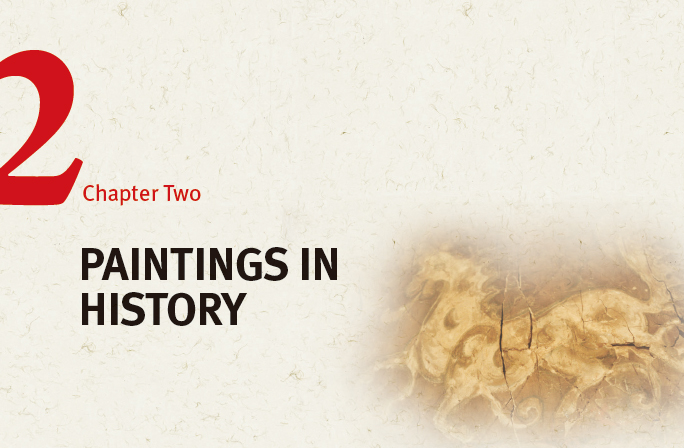
In culture, as in fine arts, tradition is not simply a legacy from the past. The richer and greater a tradition from the past is, and the better it is understood and upheld by its inheritors, the greater chance it has of developing into a more advanced culture. Conversely, if a tradition is weak and neither well understood nor well utilized, there is less chance for cultural development. By its very nature, tradition brings consistency to the culture of a particular group and makes it distinct from other groups. Korean culture thus has attributes and traditional characteristics of its own.
Here we will review the mainstream of Korean traditional painting and appraise the role of tradition in modern painting. By traditional painting, we do not simply mean Korean painting or Koreanized painting but also the paintings of ancient times as opposed to modern painting.
EARLY ARTISTIC TRADITIONS IN KOREA
Korean painting has developed steadily throughout its long history from the Three Kingdoms period (1st century BC-AD 7th century) to modern times, in spite of frequent political crises and invasions. Absorbing foreign influences—Chinese in particular—on a selective basis, Korean painting has developed its own independent styles and, to a great extent, has influenced the development of Japanese painting. Through frequent and active contact with foreign arts and artists, Korean artists cultivated their own painting styles distinct from those of other countries. At once characteristically Korean and internationally universal, the Korean painting tradition has contributed considerably to the artistic development of surrounding nations.
Korean painting, like Korean architecture, sculpture, and handicrafts, represents a pattern of cultural achievement typical of the creative vigor and aesthetic sense of the Korean people.

Hunting Scene in the Tomb of the Dancers. This spirited style originated in the early days of the Goguryeo kingdom and became firmly established in the later period. (Jillin Province, China)
THREE KINGDOMS
From the 1st century BC to the mid-7th century, the Korean Peninsula was divided into the three kingdoms of Goguryeo, Baekje, and Silla, which battled with one another for power. This era, called the Three Kingdoms Period, began when the kingdoms first broke away from their initial tribal state framework to establish nation-state systems, and continued until the year 668, when Silla unified the three kingdoms.
During this time, the kingdoms moved away from their primitive state system, a process marked by the establishment of an agricultural lifestyle through the use of iron tools and the shaping of a political system to form an ancient state. At the same time, it could also be characterized as a period in which Buddhism spread to form a foundation for later spiritual culture along with Confucian ethics, while Korea solidified its position as an advanced civilization with the absorption and recreation of continental culture. Paintings in the true sense were first produced in Korea around the fourth century, roughly the midpoint of the Three Kingdoms period. The art of this period developed as the individual kingdoms traded influences with China; each would acquire pictorial characteristics of a different nature. The art of Goguryeo could be described as following a “northern” style, lively and large in scale but also somewhat coarse; Silla art was characterized by solemnity and well-arranged, soft qualities; and Baekje art boasted soft and graceful characteristics. These styles could be seen as having been strongly influenced by geographic conditions and interchange with foreign cultures.
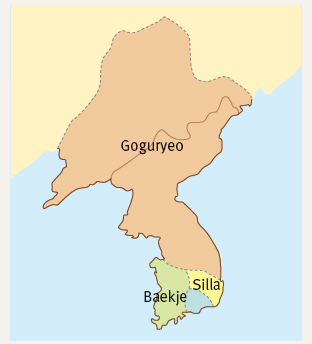
Three Kingdoms, 5th Century
The Three Kingdoms
Painting in its true sense was first produced, and the painting tradition thus began to be formed, in the Three Kingdoms period. The three countries, Goguryeo, Silla, and Baekje, absorbed foreign influences and developed their own distinct artistic styles while maintaining a close interrelationship.
The painting style of Goguryeo (37 BC-AD 668), which ruled the northern part of the Korean Peninsula, was marked by vitality and rhythmic movement, as shown in the murals found in the tombs near Tong-gou in Manchuria and Pyongyang. Best represented by the hunting scene in the Tomb of the Dancers, this spirited style originated in the early days of the kingdom and became firmly established in the later period. The murals in the Tomb of Four Cardinal Deities in Tong-gou and Jinpa-ri No. 1 Tomb are also good examples of Goguryeo’s energetic, rhythmic style. Judging from these murals, painting began to develop in Goguryeo around the 4th century at the latest, firmly established its own tradition by the 6th century, and matured fully in the early 7th century.
The Goguryeo painting style was transmitted to the Baekje Kingdom (18 BC-AD 660). Influenced artistically by Goguryeo and the Southern Dynasties of China, especially the Liang (502-557), Baekje developed elegant and refined styles quite unique to it. As exemplified by the Lotus Flower and Flying Clouds painted in the Neungsan-ri Tomb and the ornamental tiles with landscape designs in relief that were excavated from Gyuam-ri, the artistic work of Baekje is elegant and relaxed, a remarkable contrast to the dynamic Goguryeo style.
The painting style of Silla (57 BC-AD 668) is evident in a number of folk paintings, including the Cheonmado (Heavenly Horse Painting) excavated in Gyeongju. Obviously influenced by Goguryeo and Baekje, these paintings, though inferior, show qualities that are quite distinct from those of the other two countries. While the paintings of Goguryeo are dynamic and rhythmic and those of Baekje elegant and refined, the paintings of Silla are somewhat speculative and meticulous.
Lotus flowers in an ancient tomb in Goa-dong, Goryeong, represent the painting of the Gaya Kingdom (42-532). Though they are seriously damaged, the eight-petaled, double-layered flowers are remarkably well depicted in strong colors, indicating that Gaya enjoyed an advanced painting tradition that was undoubtedly brilliant and refined.
Thus, each of the ancient nations of the Korean Peninsula developed its own style, despite strong influences from China and close cultural interchange amongst themselves. Their painting styles and tradition were transmitted to Japan and contributed to the development of Japanese art. These diverse painting styles are believed to have integrated and blended into one after Silla’s unification of Korea in 668, as was also the case with Buddhist sculpture and handicrafts. Ancient records, available only in fragments, indicate that portraits for the royal court’s entertainment, blue-green colored landscapes, and Buddhist paintings prevailed at the time as a result of active cultural exchanges with Tang China (618-907). Heaven and Hell, the frontispiece of a scroll of the Avatamsaka Sutra, depicts well-balanced human figures in elaborate lines. This is an eloquent testimony to the great heights achieved in Buddhist painting during the Unified Silla period, much like Buddhist sculpture in the mid-8th century.
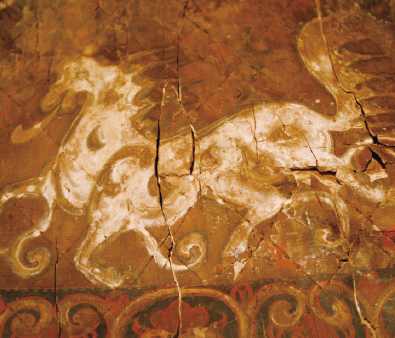
Cheonmado (Heavenly Horse Painting, excavated in Gyeongju, 5th C)
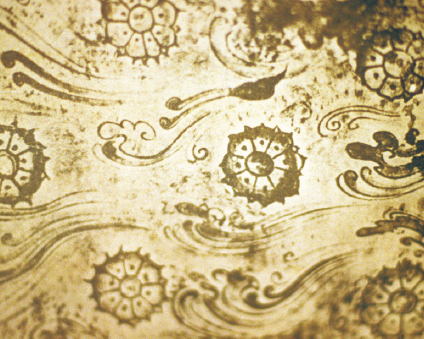
Lotus Flower and Flying Clouds in Neungsan-ri Tomb (Buyeo, Chungnam, 6th C)
A DEPICTION OF LIFE IN THE GRAVE
Tomb murals could be described as the earliest brush drawings to be found in Korea. The murals were painted using fresco techniques, and their location within tombs sheltered them from much of the outside climatic environment, enabling their preservation over many long years. In particular, the tomb murals of Goguryeo were relatively safe from theft and damage due to the distinctive style of the “cave-style stone room tombs.” (In this style, a room was built with an entrance connecting with the outside at one end of the tomb wall, which was subsequently sealed with earth.) Unfortunately, because these tomb murals are principally located within what is today Chinese and North Korean territory, the former territory of Goguryeo, they are difficult to view directly and inadequately represented in the historical record, placing many constraints upon research by South Koreans.
Of all the paintings of the Three Kingdoms period, the Goguryeo tomb murals unquestionably have the greatest wealth of representation in the historical record. Unfortunately, with the exception of the Silla Cheonmado, the tomb murals of Silla and Baekje have suffered such damage over the years that only traces remain for viewing. Looking at the Goguryeo tomb murals gives us a window into the origins of Korean art, allowing us a glimpse into the lives of people in that era, their views on life and death, their understanding of the world, and their artistic consciousness.
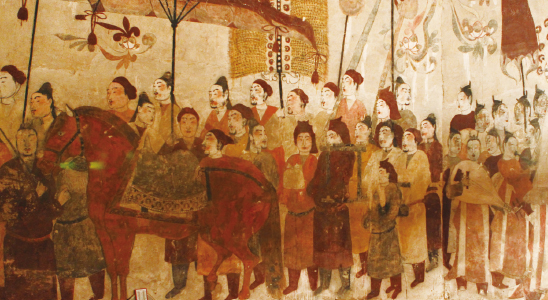
Anak Tomb No. 3. Goguryeo tomb murals unquestionably have the greatest wealth of representation in the historical record. (North Korea, 357)
It is quite certain that Balhae (698-926), established in Manchuria by Goguryeo refugees after the downfall of their kingdom, also achieved a fine painting tradition. Judging from the figures portrayed in the tomb of Princess Jeonghyo (757-792), Balhae developed an excellent painting style in the tradition of Goguryeo with elements absorbed from Tang painting. Especially noteworthy are the lavish depictions of human figures, flowing lines, and beautiful colors.
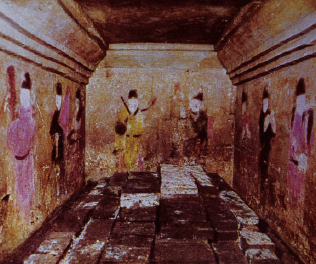
Tomb of Princess Jeonghyo. Balhae developed an excellent painting style in the tradition of Goguryeo with elements absorbed from Tang painting. (793, China)
UNIFIED SILLA AND BALHAE
After strengthening royal authority with the adoption of Buddhism around the 6th century, Silla dominated the Han River basin from around the 7th century and established the Silla-Tang alliance, which would bring down Baekje in 660 and Goguryeo in 668. It subsequently drove out the Tang army and achieved unification of the Three Kingdoms. With the establishment of Balhae to the north in 698, Silla became the southern axis of the North and South States period.
Following unification, Silla established an advanced system of centralized authority; it is also during this time that many elaborate and beautiful Buddhist structures and crafts were built or produced. Toward the end, however, rebellions broke out all over as the king and aristocracy indulged in luxury and failed to afford proper attention to politics. In 935, Silla finally surrendered to Taejo Wang Geon of Goryeo, coming to an end after 56 generations and 992 years.
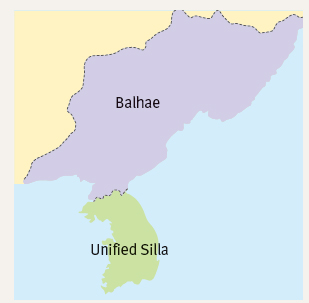
Unified Silla and Balhae, 7th Century
Meanwhile, Balhae carried on the mantle of Goguryeo following its defeat at the hands of the Tang Dynasty and Silla. For 229 years, it occupied the majority of the old Goguryeo territory, an expanse that covered the northern Korean Peninsula (where North Korea is today) and large portions of what today belongs to the People’s Republic of China and Russia. In terms of its culture, it established a system with strongly Buddhist elements overlaid atop the Goguryeo culture, and held on to its position as a cultural power by maintaining exchange with Tang China and incorporating aspects of its culture.
The Goryeo Period (918-1392)
The art of painting flourished in great variety during the Goryeo period. A new tradition developed as paintings began to be produced not only for practical purposes but also for appreciation and spiritual cultivation by artists for whom painting was an avocation and not a profession. Unlike in previous periods, members of the nobility and Buddhist clergy often enjoyed painting and so contributed to the broadening of the art.
One of the important developments in this period was the emergence of a trend of painting landscapes based on actual sketches. Historical records indicate that Goryeo’s greatest painter, Yi Nyeong, painted Yesong River View and South Gate of Cheonsusa Temple. In addition, works by unknown Goryeo artists, such as Mt. Geumgangsan, Landscape of Jin yang and Eight Views of Songdo, of which only records remain today, testify to the prevalence of this trend.
Though it was not linked directly to the Joseon era school of Jeong Seon (1676-1759), who painted landscapes based upon actual Korean scenes and subjects, the new trend nevertheless set the precedent for the depiction of actual Korean scenery. For one thing, the trend indicates that painting was already naturalized in the Korean cultural climate and had developed an independent tradition by the early 12th century when Yi Nyeong was active.

Water-Moon Avalokitesvara.
Goryeo Buddhist paintings are extremely elaborate and, much like the celadon ware of the same period, evince a penchant for aristocratic artistry. (14th C, Amore Pacific Museum of Art)
Goryeo Buddhist paintings, as seen in several dozen works extant in Japan, are extremely elaborate and, much like the celadon ware of the same period, evince a penchant for aristocratic artistry. They are all marked with the same stylistic idiosyncrasies in composition, poses of figures, and rendering of folds and patterns in drapery.
The Joseon Period (1392-1910)
It was during the Joseon period that Korean painting came into full bloom and established a firm tradition. Talented painters from the Royal Academy of Painting, (or Dohwaseo), and prominent literati painters contributed greatly to the development of traditional styles. Painting became more diverse and Korean elements more prominent than in the preceding period, especially in terms of composition, brushwork, treatment of space, and the depiction of trees.
Selectively absorbing the styles of Chinese masters from the Song, Yuan, Ming, and Qing periods, Korean painters were able to evolve their own styles. They also played an important part in the development of ink painting in Japan. In this sense, the tradition of Joseon painting was international and at the same time very distinctive.
It was during the reign of King Sejong (r. 1419-1450) that the Korean tradition was firmly established, thanks to great masters like An Gyeon, Gang Hui-an (1417-1464), and Prince Anpyeong (1418-1453). These early Joseon painters based their work on the Goryeo painting tradition and at the same time absorbed and assimilated highly advanced Chinese traditions to develop their own styles.
An Gyeon was especially successful in developing an individual style based on the style of Guo Xi of Northern Song China. An’s style was characterized by an unbalanced yet harmonious composition, a concept of space that valued blankness, an efficient application of diagonal movement, and highly distinctive brushwork. He had a great influence on the painters who followed him.
The painters of the 16th century showed a strong tendency toward conventionality and adhered to the style of the previous century, a fact that reaffirms the generally held belief that the roots of the Korean painting tradition were firmly implanted by the early Joseon period.
The Korean style of painting was able to maintain its unique character despite the four destructive foreign invasions that swept the country in the mid-Joseon period (ca. 1550-1700) mainly because the tradition was so firmly established in the earlier period. During this politically turbulent era, the early Joseon tradition was handed down through the perpetuation of the An Gyeon school, the emergence of the Zhe school, and the development of a number of distinctly Korean artistic idioms, as seen in the depiction of birds and animals and ink paintings of flowers and birds, plums, and grapes. Kim Je (1524-1593), Yi Kyeong-yun (1545-1611), Kim Myeong-guk (1600-?) and Jo Sok (1596-1668) were artists active during this period.
THE DOHWASEO
The Dohwaseo was a royal academy responsible for court paintings, officially under the purview of the Yeojo, the Joseon ministry in charge of education. Fifteen art students were sent to the academy, which not only produced painters but also handled paintings of all national rites and events as well as portrait paintings. In 1746, with the importance of painting on the rise again, the number of students was increased from 15 to 30.
Called hwawon, the painters of the Dohwaseo carried out all painting duties for the state and royal house, maintaining close relationships with the gentry and satisfying their demands while at the same time working assiduously to realize their own pictorial achievements. Viewed in terms of the overall trends and currents of the painting world, the hwawon formed one of two major axes leading the painting world during the Joseon era, the other being the literati of the gentry, who adopted a more casual approach to painting. The hwawon were mainly in charge of paintings for practical and archival purposes. In ordinary painting as well, they contributed to the development of a distinctively Korean pictorial beauty, establishing and expanding upon new painting styles adopted from China by the gentry and creating a style all their own.
Most students came from the middle jungin class, and the academy would produce many of Korea’s great painters, including Kim Hong-do. It played a leading role in the development and continuation of Korean painting styles, and, in an age without photographs, its paintings of royal rites are priceless historical materials that provide a look into the culture of Joseon Korea.
The Korean style became even more pronounced in the paintings of the late Joseon period (ca.1700-1850), which were comparable to the early Joseon paintings in terms of artistic standards. Whereas the early painters developed a native style by carrying on the tradition of Goryeo and absorbing Chinese influences from the Song and Ming, the style of the later period manifested a national awareness on the part of the artists even as they embraced Ming and Qing styles.
This national awareness surged during the reigns of Yeongjo (r. 1724-1776) and Jeongjo (r. 1776-1800) and played a vital role in society and culture in general during the late Joseon period. Just as many scholars of the time turned away from pedantic Neo-Confucian precepts in favor of the progressive ideals of Silhak (Practical Learning), painters began to base their work on the native scenes and life style of their country.
Western techniques of shading and perspective were brought to Qing China by Jesuit missionaries and were, in turn, introduced to Korea by members of the Korean mission to Yenjing.
Western techniques began to be adopted by 18th century painters, including Kim Du-ryang (1696-1763), Gang Se-hwang (1712-1791), and Yi Hui-yong. They also found their way into academy painters’ renditions of royal ceremonies as well as folk paintings, such as chaekgeori (paintings of books and scholars’ utensils).
The methods absorbed by Korean painters at the time, however, were very different from today’s oil painting. Shading and perspective, which the artists blended into their ink paintings, were the only Western elements introduced. The new technique was far from prevalent but spread broadly enough to herald the modernization of Korean art. It also provided a turning point for the development of a totally unusual style in the 19th century.
In the meantime, during the final years of Joseon (ca. 1850-1910), the landscape and genre painting styles found in the earlier period declined, giving way to the Chinese Southern School style (Namjonghwa) promoted by Kim Jeong-hui (1786-1856) and his adherents. In addition, a fresh and unusual style was initiated by a number of markedly individualistic artists, including Kim Jeong-hui and his followers, Jo Hui-ryong (1789-1866), Heo Ryeon (1809-1892), Jeon Gi (1825-1854), and Kim Su-Cheol. While Kim Jeong-hui kept alive the scholarly style of the Chinese Southern School, Kim Su-cheol and Kim Chang-su developed new modes based on that style. Their work foreshadowed the predominance of the Chinese style in modern Korean ink painting. Despite the pervasive influences of the late Qing styles, the painting of this period was marked by strong individuality and became the basis for modern Korean painting.
Social and political upheavals in the late 19th century caused a decline in painting, even though literati painters such as Yi Ha-eung (1820-1898), Min Yeong-ik (1860-1914), and other followers of Kim Jeong-hui were quite prolific with their ink brush renderings of orchids. So too was Jeong Hak-gyo (1832-1914), with his depictions of strangely shaped rocks.
One figure who stands out in this period of relative artistic stagnation was Jang Seung-eop (1843-1897). Excelling in a wide range of subjects including landscapes and flowers, Jang had a profound influence on later painters. His style was passed on to modern Korean painters by his two followers, An Jung-sik and Jo Seok-jin. Together with Heo Ryeon, Jang clearly played an important role in the emergence of modern Korean painting.
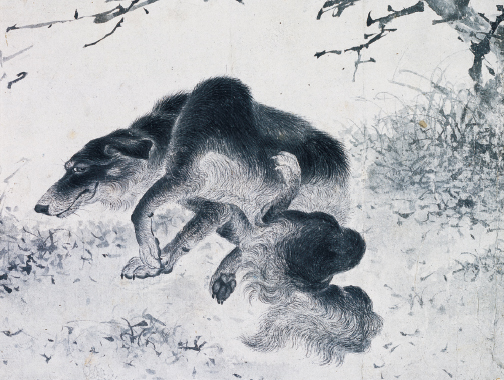
Black Dog. Western techniques began to be adopted by 19th century painters. (Kim Du-ryang, 18th C, National Museum of Korea)
Although he was endowed with outstanding skill, Jang lacked the lofty spirit of a learned man, for he had no opportunity to study the theories of eminent scholars such as Prince Anpyeong and Gang Se-hwang, with which earlier masters such as An Gyeon, Jeong Seon, and Kim Hong-do were familiar. Jang’s style was characterized by powerful brushwork and vivid coloring that is apparent in his landscapes, but his paintings remained inferior in spirit to the work of earlier masters. Another regrettable point is that his work is permeated by a strong Chinese ambience in both style and content.

Intrepid Hawk. No other Korean artist better grasped the intricate nature of Jang’s object. (Jang Seung-eop, 19th C, Leeum, Samsung Museum of Art)
A Difficult Period for Traditional Painting
Korean painters selectively absorbed Chinese styles throughout the long history of Korean painting while at the same time maintaining and creating their own styles. Following the political disorder brought on by the Japanese annexation of Korea in 1910, however, the traditional styles of Korean painting tended to deteriorate.
Traditional painting bore the brunt of the Japanese colonial authorities’ policies aimed at systematically obliterating Korea’s cultural tradition. Historians patronized by the Japanese exaggerated Chinese influences on Korean culture as a means of belittling Korea’s individuality as well as justifying Japan’s colonial rule. This so called “colonial view of history” pervaded every cultural sphere, so that the public became uncertain of or even oblivious to its own cultural tradition. The impact on Korean painting was extremely damaging, and the scars remain today. Korean traditional painting was deliberately excluded from academic studies and educational programs and undermined by an upsurge in the influence of Japanese painting.
The Japanese predilection for well-manicured styles like that of the Ma-Xia school established during the Southern Song period meant that Korean painting was condemned as crude and branded as a mere imitation of Chinese painting. Victimized by the colonial view of history for so long, the tradition of Korean painting withered, resulting in a vacuum into which Japanese styles moved with remarkable ease. Prejudices about Korean painting and Japan’s influence during this period persisted long after Japanese colonization ended.
Western oil painting was introduced at this time and grew to be very influential. The Joseon Art Exhibition was launched in 1921 as an example of the Japanese colonial regime’s “enlightened administration.” Held annually until 1944, this exhibition played a decisive role in smothering Korean painting in Japanese influences. Innumerable Korean artists were indoctrinated in Japanese-style painting at Japanese art schools and had no choice but to participate in the exhibition in order to become successful artists.
As a result, the Korean painting community underwent a process of Japanization, which in turn caused a deterioration of Korea’s painting tradition. The Japanization of the Korean Peninsula did not simply mean the transplantation of foreign painting styles but also the contamination of Korean aesthetics with Japanese styles and aesthetic standards, which entrenched themselves so deeply in Korean art during those years that they remain very much alive in some of Korea’s established artists and, through them, have been transmitted to younger generations of artists.
In many ways, Korean painting owes its survival to the Calligraphy and Painting Society led by An Jung-sik and Jo Seok-jin. Founded in 1918, the society was these Korean painters’ answer to the Japanese Joseon Art Exhibition. Representing a nationalist art movement, it succeeded in organizing 15 annual exhibitions from 1921 until it was closed down by the Japanese in 1935. However, the quality of the participating painters’ work was already much inferior to that of Joseon period artists.
The waning of the Chinese influences that had long been a stimulant to the development of Korean painting, the deterioration of Korean painting in general since the days of Jang Seung-eop, and a combination of social and political factors brought on by Japanese colonial policy coalesced to throw traditional Korean painting into its most serious crisis. It managed to survive, however, though barely, thanks to the activities of a few nationalist artists. After Korea’s liberation from Japan, the tradition of Korean painting was revived by a number of outstanding artists, who even succeeded in making some fresh developments.
Traditional painting deserves more intensive study. At this point, we need an artistic climate that encourages a thorough understanding of tradition in order to form the basis for the development of new styles. Tradition is not an obsolete relic of the past but something organic that enriches the present and inspires the future. As amply demonstrated by its past tradition, Korean painting will continue to develop brilliantly under the leadership of gifted, hardworking artists.

Saints Crossing the Sea (An Jung-sik and Jo Seok-jin, 1892, Hanyang University Museum)
“Saints Crossing the Sea claims great significance in that it inherited the tradition of Joseon’s paintings of saints crossing the sea, a kind of painting that was been constantly created from the middle to the end of the dynasty, and that it’s a good example of Taoist and Buddhist figure paintings with the powerful reflection of Korean traits.”
- Bae Won-Jung, Curator of the Hanyang University Museum